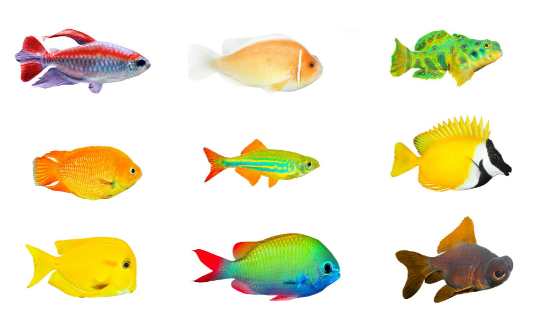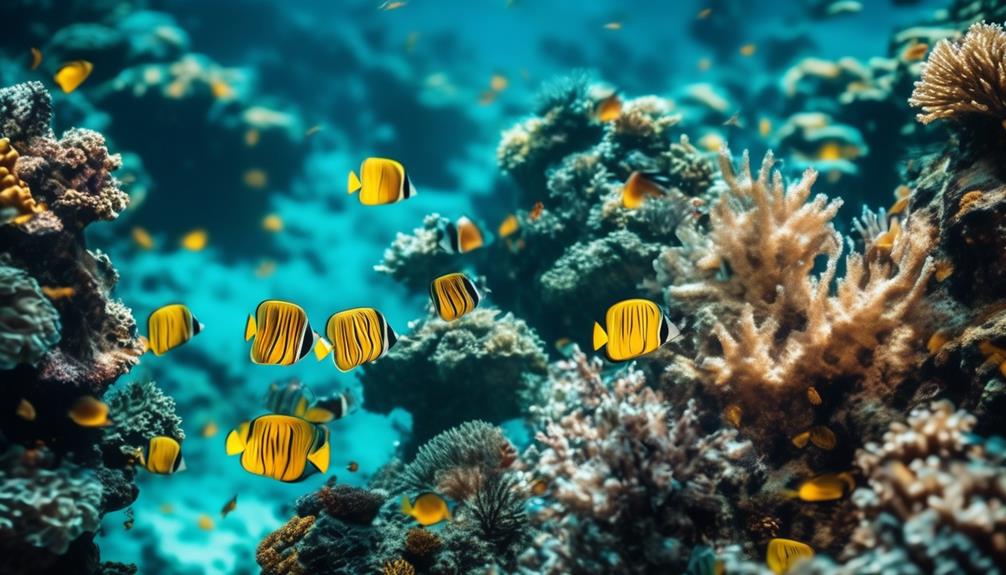
Did you know that butterflyfish are not only breathtakingly beautiful but also incredibly elusive creatures? With their vibrant colors and intricate patterns, they are a sight to behold. But what makes them even more fascinating is their ability to disappear into their surroundings, making it a challenge to study and observe them in their natural habitat.
In this article, we will explore the secrets behind the dazzling beauty and elusive nature of butterflyfish, uncovering the mysteries that surround these captivating creatures. So, get ready to dive into the world of butterflyfish and discover the hidden wonders that await.
Key Takeaways
- Butterflyfish are a large family of saltwater fish known for their dazzling colorations and patterns, which serve as a defense mechanism.
- They have specific dietary and environmental requirements, relying on live rock and coral as a food supply, and needing large swimming spaces and hiding spots.
- While generally peaceful, some species can be territorial and aggressive, so careful consideration is needed when selecting tank mates.
- Breeding butterflyfish in an aquarium environment is extremely challenging due to demanding water parameters and the delicate nature of the larvae stage.
General Description and Characteristics
Butterflyfish, with their compressed, disk-shaped bodies and dazzling colorations, are an enchanting sight in the world of saltwater fish. Resembling angelfish in appearance, these fish belong to a large family of over 100 distinct species. Their vibrant colors and patterns serve as an evolutionary defense mechanism, helping them blend into their coral reef habitats.
Found in reefs worldwide, butterflyfish are known for being one of the most colorful species of saltwater fish. When it comes to care and maintenance, these fish have specific dietary and environmental requirements. They rely on live rock and coral as a food supply and need large swimming spaces and hiding spots. While generally peaceful towards other fish, some butterflyfish can be territorial and aggressive. It's important to thoroughly research their feeding habits before purchase, as a varied diet contributes to their vibrant colorations.
Despite their popularity among hobbyists, breeding butterflyfish in an aquarium environment is extremely challenging due to demanding water parameters and delicate larvae stage. In the wild, butterflyfish form breeding pairs that mate for life, but breeding pairs are rarely successful in captivity. With different varieties available, each with its own unique characteristics and colorations, butterflyfish remain a captivating and elusive choice for aquarium enthusiasts.
Species Diversity and Abundance
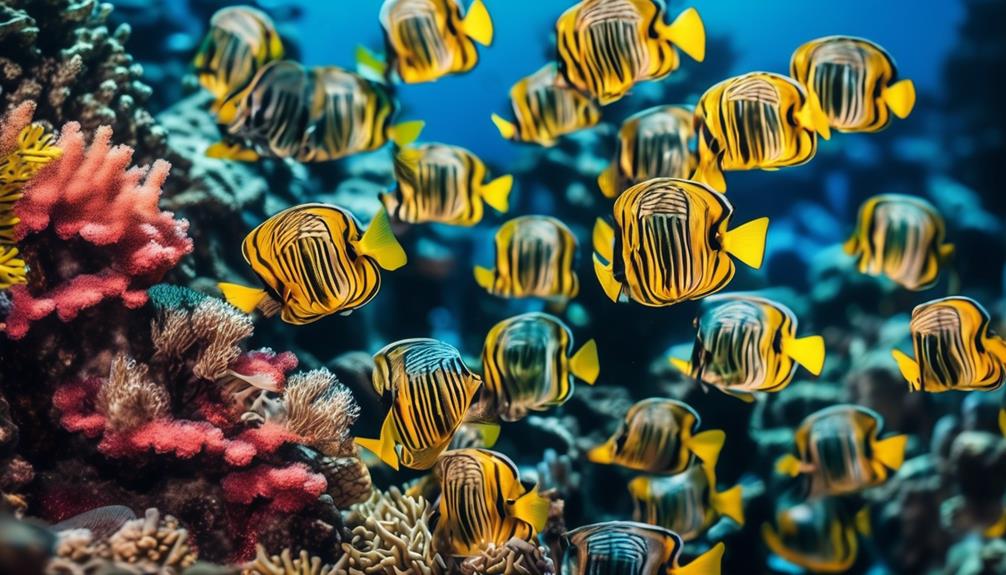
With over 100 distinct species, the world of butterflyfish is teeming with a diverse array of dazzling colors and patterns. Each species has its own unique characteristics, making them a sight to behold in coral reefs around the world.
From the vibrant yellow of the Auriga butterflyfish to the striking black and white markings of the Raccoon butterflyfish, these creatures never fail to capture the attention of divers and snorkelers. While some species display bold and eye-catching colorations, others possess more subtle and intricate patterns, blending in with their surroundings.
Despite their abundance, each species has its own specific habitat requirements and feeding habits, contributing to their unique distribution and ecological role within the coral reef ecosystem.
The sheer variety and abundance of butterflyfish species highlight the incredible beauty and biodiversity found beneath the ocean's surface.
Physical Appearance and Evolutionary Adaptations
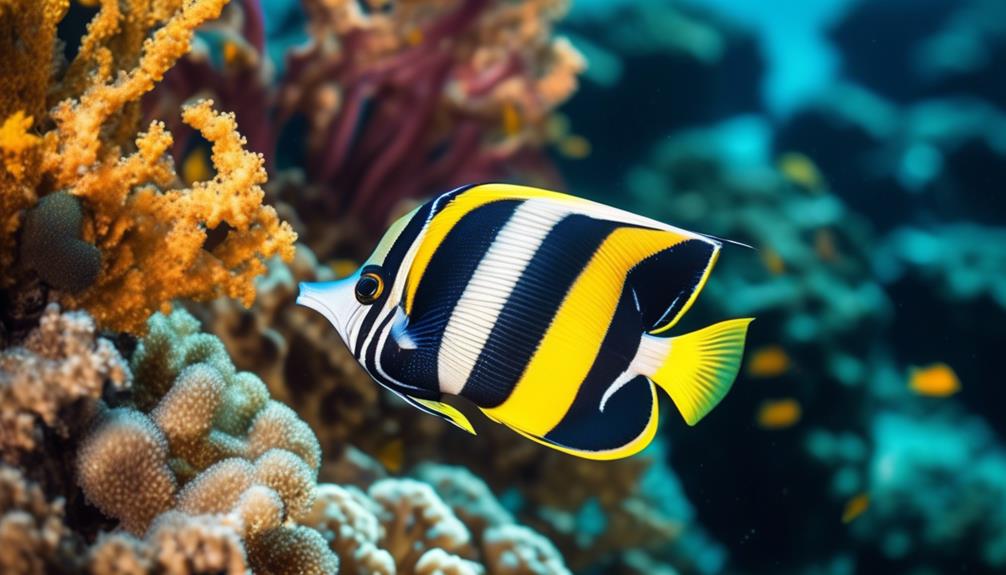
Dazzling in their colorations and patterns, butterflyfish have evolved unique physical characteristics that contribute to their elusive nature. Here are four features that make them stand out:
- Compressed, disk-shaped bodies: Resembling angelfish, butterflyfish have flat bodies that allow them to navigate through intricate coral reef structures with ease, making it difficult for predators to catch them.
- Mask-like facial patterns: Many butterflyfish have striking patterns on their faces, which resemble masks. These patterns help break up their body shape, making them less visible to predators and allowing them to blend in with their surroundings.
- Long, slender noses: Butterflyfish have elongated snouts that they use to probe into crevices and extract small prey like polyps and tiny crustaceans. This adaptation enables them to reach food sources that other fish can't access easily.
- Bright colorations: Their vibrant colors serve as a warning to potential predators, signaling that they're toxic or unpalatable. Additionally, the bold hues help butterflyfish recognize and communicate with each other, enhancing their chances of finding a mate and maintaining social order.
These physical adaptations have allowed butterflyfish to thrive in their coral reef habitats, showcasing their beauty while remaining elusive and well-equipped for survival.
Habitat and Distribution
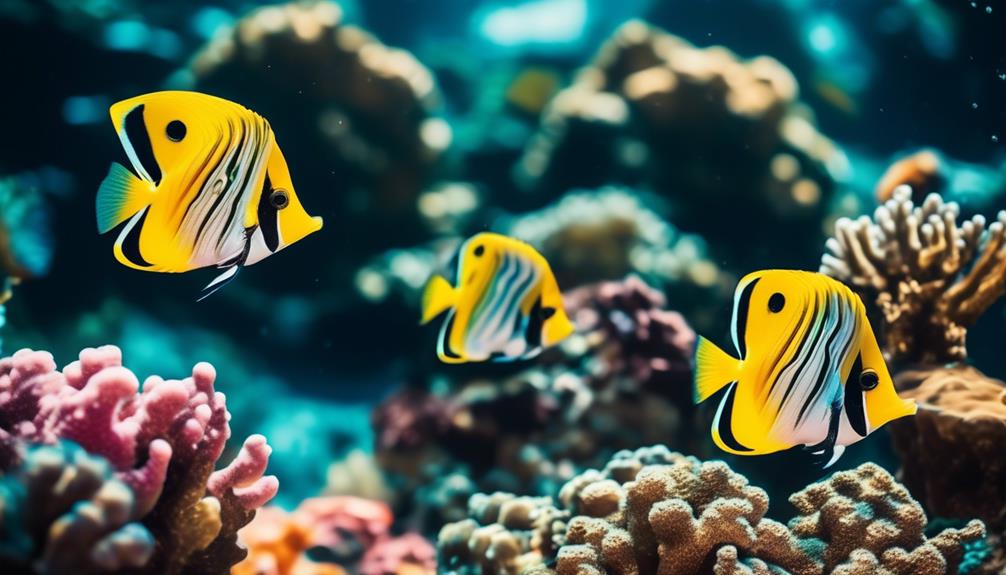
Butterflyfish can be found in coral reefs around the world, making them a fascinating species to study. These beautiful fish have a wide distribution and can be found in tropical and subtropical waters in the Atlantic, Indian, and Pacific Oceans. They are commonly found in the Red Sea, the Great Barrier Reef, and the Caribbean. Butterflyfish are well adapted to their coral reef habitats, where they rely on the coral for food and shelter. They are often seen swimming in pairs or small groups, gracefully navigating through the vibrant coral formations. Their habitat provides them with ample opportunities to display their dazzling colors and patterns, making them a true delight for underwater enthusiasts.
| Habitat | Distribution |
|---|---|
| Coral reefs | Atlantic Ocean, Indian Ocean, Pacific Ocean |
| Tropical and subtropical waters | Red Sea, Great Barrier Reef, Caribbean |
| Rely on coral for food and shelter | Widely distributed in various coral reef habitats |
| Often seen in pairs or small groups | Can be found in different regions of the oceans |
| Display stunning colors and patterns | A delight for underwater enthusiasts |
Vibrant Colors and Patterns
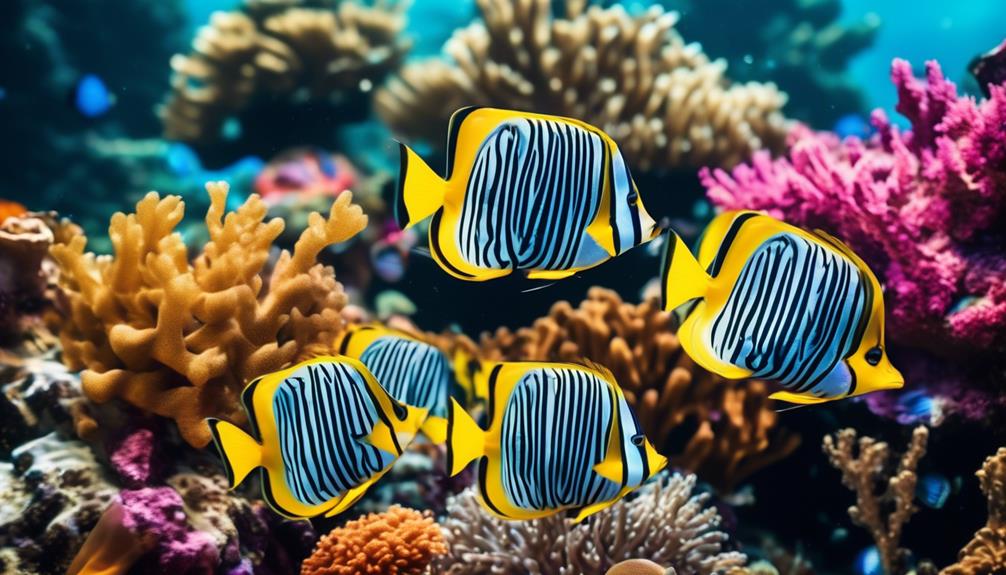
As we explore the captivating world of butterflyfish, let's now turn our attention to their remarkable ability to display vibrant colors and intricate patterns. These stunning features make butterflyfish a sight to behold in the underwater realm. Here's a glimpse into the vibrant world of butterflyfish:
- A riot of colors: Butterflyfish exhibit a wide range of hues, from electric blues and vibrant yellows to striking oranges and deep purples. Their colorful bodies are adorned with intricate patterns and bold markings, making them a true spectacle.
- Striking contrasts: Many butterflyfish species boast a striking contrast of colors, with vibrant stripes or spots adorning their bodies. These patterns not only enhance their beauty but also serve as a camouflage, helping them blend seamlessly into their coral reef habitats.
- Unique designs: Each butterflyfish species has its own unique design, with patterns that can be intricate and mesmerizing. Some species have eye-catching lines or geometric patterns, while others feature intricate mazes or intricate spots.
- Natural works of art: With their vibrant colors and intricate patterns, butterflyfish are like living works of art underwater. Their beauty not only captivates the eyes of observers but also plays a crucial role in their survival, helping them navigate their environment and communicate with other fish.
Care and Maintenance Tips
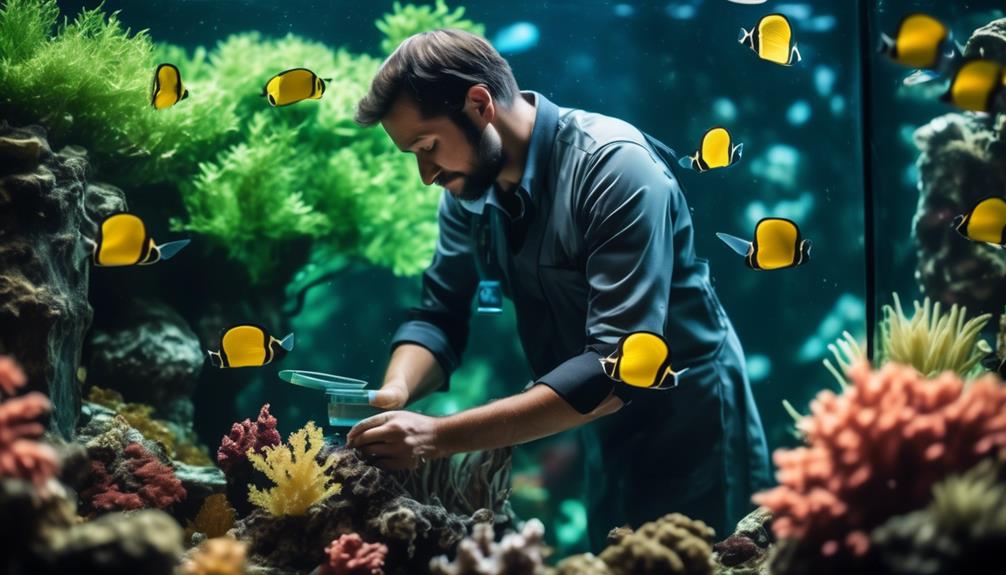
To ensure the health and well-being of your butterflyfish, it's essential to follow specific care and maintenance tips. Butterflyfish have specific dietary and environmental requirements that must be met. They rely on live rock and coral as a food supply and need large swimming spaces and hiding spots. While they're generally peaceful towards other fish, some species can be territorial and aggressive. Certain species can be kept in groups in large aquariums.
Feeding habits are important for their vibrant colorations, so it's best to feed them a varied diet of meaty and vegetarian foods such as shrimp, brine shrimp, shellfish, and seaweed sheets. Breeding butterflyfish in an aquarium environment is extremely difficult due to demanding water parameters and delicate larvae stage.
Lastly, different varieties of butterflyfish may have slightly different care requirements, so it's important to research and understand the specific needs of the variety you have.
Dietary and Environmental Requirements
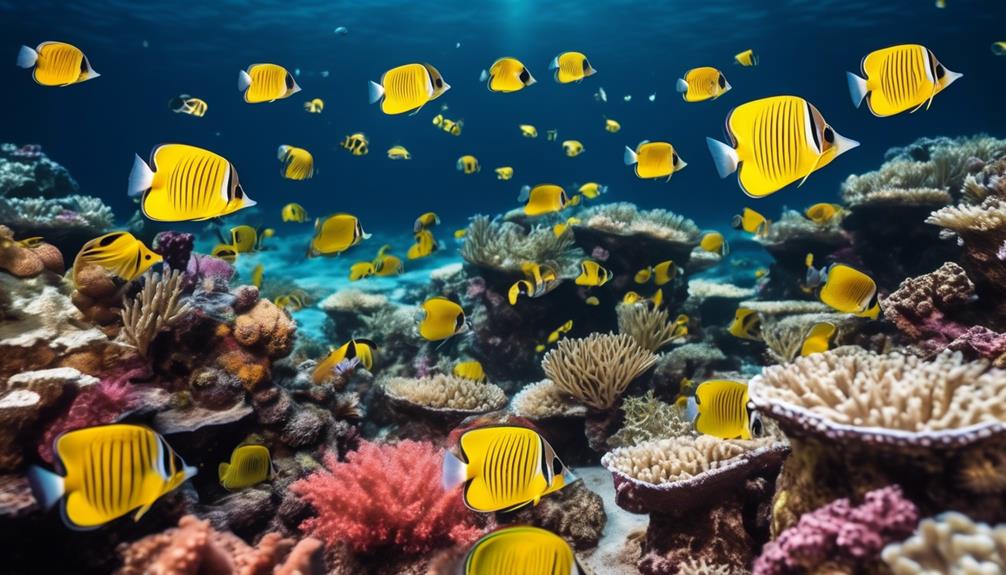
To properly care for your butterflyfish and meet their specific needs, it's crucial to understand their dietary and environmental requirements. Here are the key points to consider:
- Diet: Butterflyfish thrive on a varied diet of both meaty and vegetarian foods. Offer them shrimp, brine shrimp, shellfish, and seaweed sheets to ensure a balanced nutrition. Some species have specific dietary requirements, so it's important to thoroughly research their needs before purchasing.
- Environment: Butterflyfish require large swimming spaces and hiding spots in their aquariums. They rely on live rock and coral as a food supply and also for shelter. It's important to provide them with a suitable environment that mimics their natural habitat.
- Peaceful Nature: While butterflyfish are generally peaceful towards other fish, some can be territorial and aggressive. Certain species can be kept in groups in large aquariums, but it's crucial to monitor their behavior and provide enough space for each fish.
- Vibrant Colors: The feeding habits of butterflyfish contribute to their vibrant colorations. Offering a varied diet and proper nutrition is essential to maintain their stunning appearance.
Compatibility With Other Fish
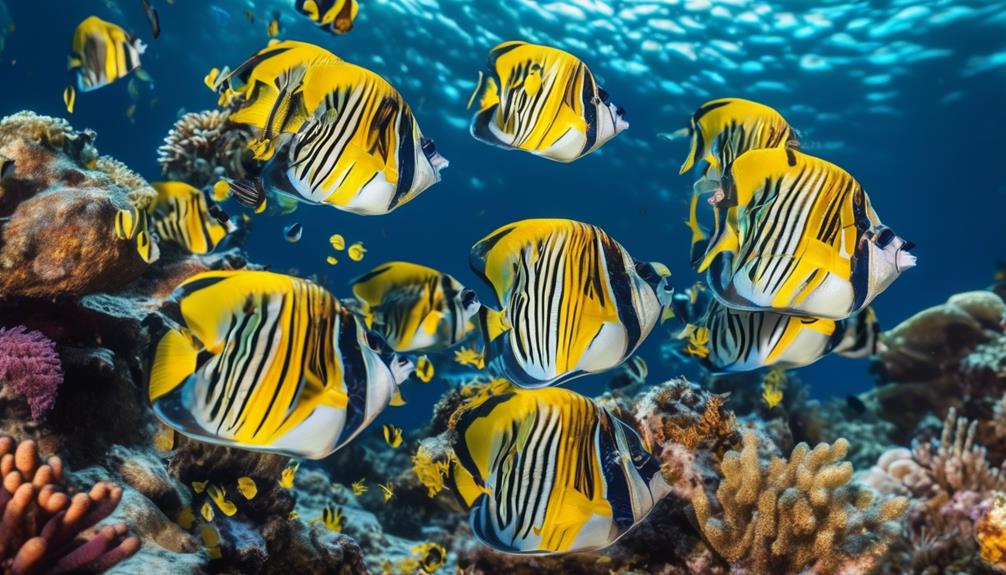
Butterflyfish are known for their generally peaceful nature and compatibility with other fish in the aquarium. They can coexist harmoniously with a variety of tankmates, as long as their specific needs and temperaments are taken into consideration. To better understand the compatibility of different butterflyfish species with other fish, refer to the table below:
| Butterflyfish Species | Compatibility with Other Fish |
|---|---|
| Raccoon Butterflyfish | Peaceful, suitable for community tanks |
| Auriga Butterflyfish | Can be territorial, best kept with non-aggressive tankmates |
| Longnose Butterflyfish | Generally peaceful, suitable for community tanks |
| Teardrop Butterflyfish | Can be territorial, best kept with non-aggressive tankmates |
It is important to note that individual personalities and temperaments can vary within each species. Proper research and observation should be done before adding butterflyfish to a community aquarium to ensure compatibility and avoid any potential conflicts.
Keeping Butterflyfish in Groups
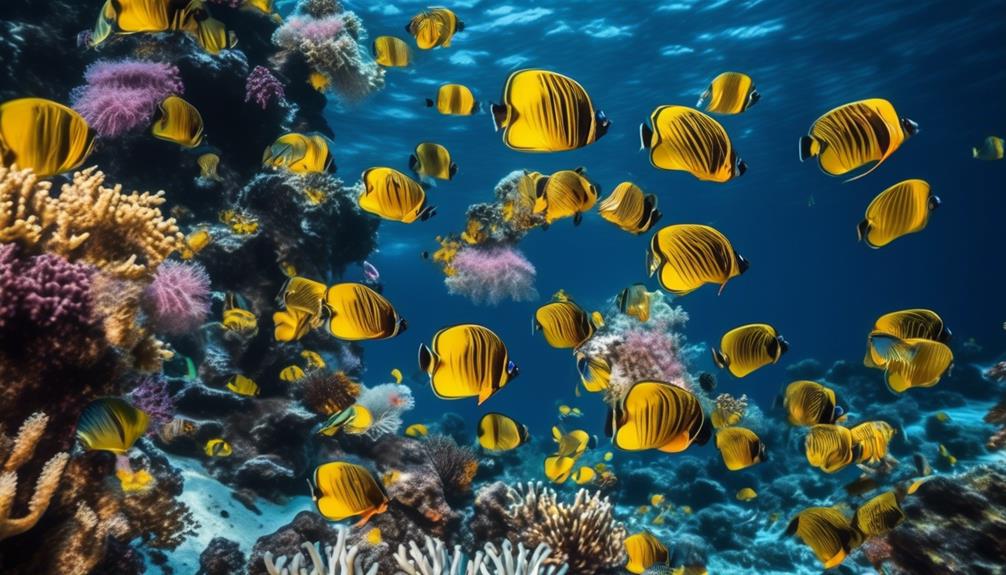
If you want to keep butterflyfish in groups, it's important to consider their social behavior and specific care requirements. To successfully maintain a group of butterflyfish in your aquarium, follow these guidelines:
- Tank size: Provide a large aquarium with plenty of swimming space for the butterflyfish. A minimum tank size of 75 gallons is recommended for a small group.
- Hiding spots: Create multiple hiding spots using live rock and coral formations. Butterflyfish appreciate places to retreat and feel secure.
- Compatible species: Choose butterflyfish species that are known to thrive in groups, such as the Raccoon or Auriga butterflyfish. Avoid mixing aggressive or territorial species with the group.
- Feeding strategies: Ensure that each butterflyfish in the group receives enough food. Some butterflyfish can be shy eaters, so consider using feeding stations or hand-feeding to ensure proper nutrition.
Feeding Habits and Nutritional Needs
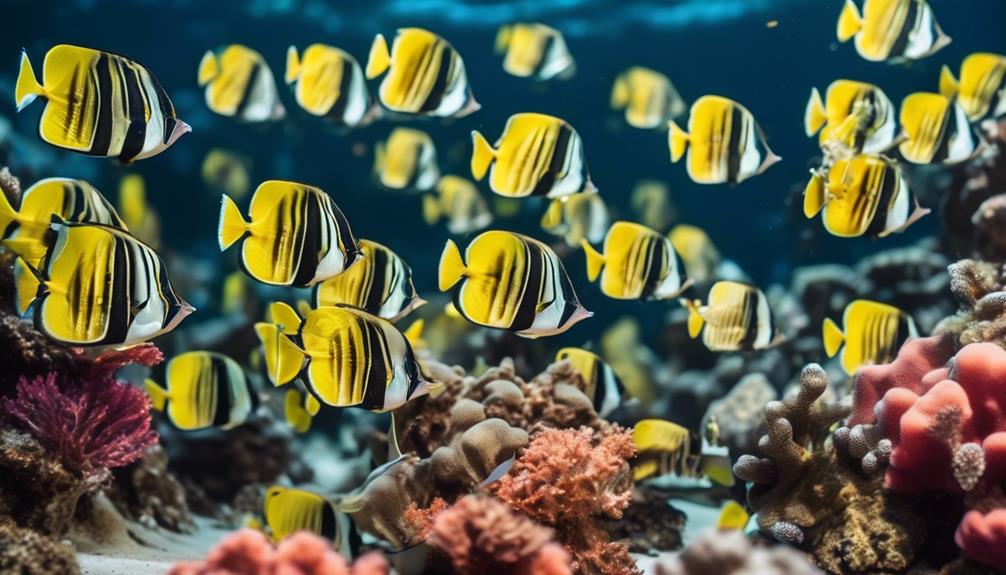
Feeding habits and nutritional needs play a crucial role in maintaining the health and vibrant colorations of butterflyfish. These beautiful creatures require a varied diet that includes both meaty and vegetarian foods. To keep them healthy and vibrant, you can feed them shrimp, brine shrimp, shellfish, and seaweed sheets.
However, it's important to note that different species of butterflyfish may have specific dietary requirements, so it's essential to thoroughly research their needs before bringing them home.
Importance of Researching Dietary Requirements
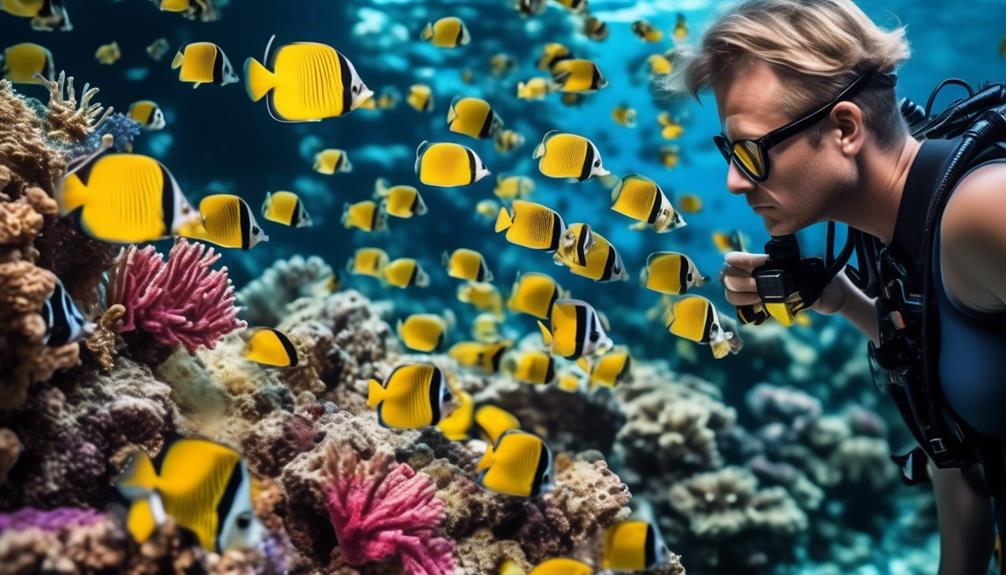
Before bringing home a butterflyfish, it's crucial to thoroughly research their specific dietary requirements. Here are four reasons why researching their dietary needs is important:
- Proper nutrition: Understanding the dietary requirements of butterflyfish ensures that you provide them with the right balance of nutrients. A varied diet of meaty and vegetarian foods, such as shrimp, brine shrimp, shellfish, and seaweed sheets, is best for their health.
- Vibrant colorations: Feeding habits contribute to the vibrant colorations of butterflyfish. By meeting their dietary needs, you can enhance and maintain their stunning and eye-catching appearance.
- Health and longevity: Providing a suitable diet promotes the overall health and longevity of butterflyfish. Meeting their specific dietary requirements helps prevent malnutrition and related health issues.
- Behavior and compatibility: Proper nutrition can also affect the behavior and compatibility of butterflyfish. Understanding their dietary preferences can help you select suitable tank mates and create a harmonious aquatic environment.
Challenges of Breeding Butterflyfish
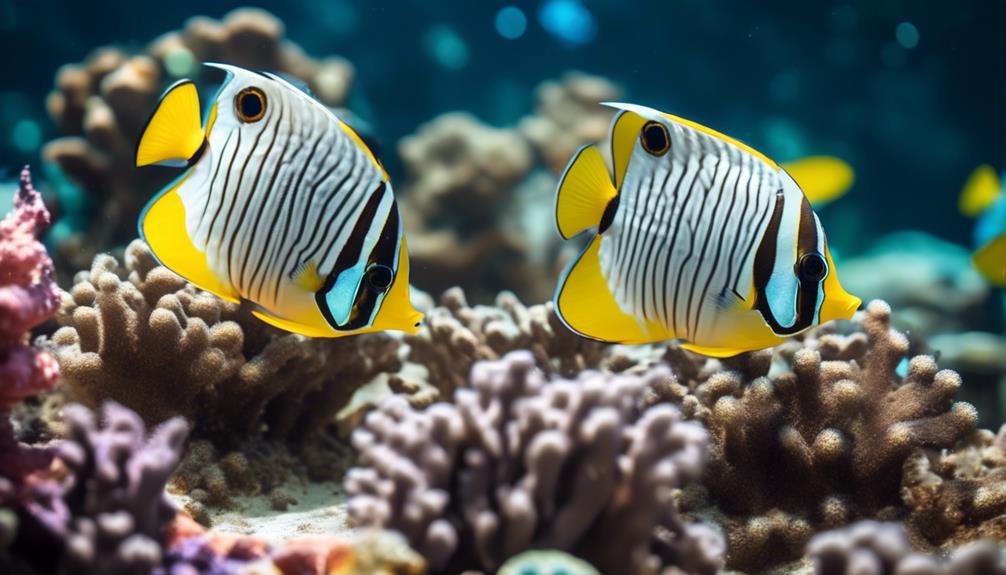
Understanding the importance of researching dietary requirements for butterflyfish, it is now crucial to address the challenges that come with breeding these captivating saltwater fish. Breeding butterflyfish in an aquarium environment is extremely difficult due to their demanding water parameters and the delicate larvae stage. In the wild, butterflyfish form breeding pairs that mate for life, but breeding pairs are rarely successful in captivity. The table below summarizes the main challenges of breeding butterflyfish:
| Challenges of Breeding Butterflyfish |
|---|
| Extremely demanding water parameters |
| Delicate larvae stage |
| Formation of breeding pairs in the wild |
| Limited success of breeding pairs in captivity |
These challenges highlight the complexities and obstacles faced by breeders in their efforts to successfully reproduce butterflyfish in an artificial environment. Despite these challenges, the allure of breeding these vibrant and elusive fish continues to captivate aquarium enthusiasts around the world.
Difficulties in Maintaining Ideal Water Parameters
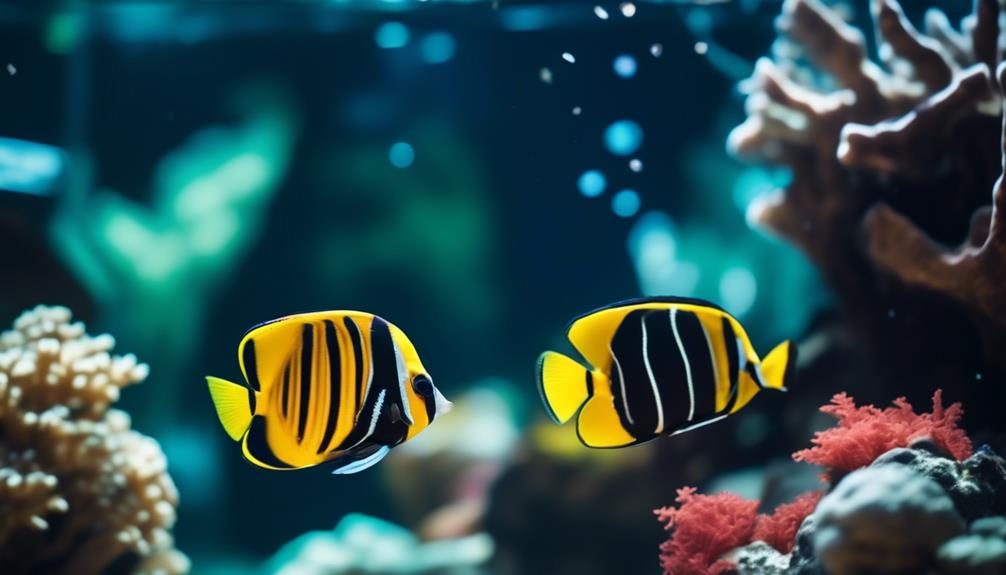
Maintaining ideal water parameters for butterflyfish can be challenging due to their specific needs and sensitivity to changes in their aquatic environment. To provide the best care for these beautiful creatures, you must pay close attention to the following:
- Temperature: Butterflyfish thrive in water temperatures ranging from 74 to 78 degrees Fahrenheit (23 to 26 degrees Celsius). Even slight fluctuations can cause stress and health issues.
- pH Levels: It's crucial to maintain a pH level between 8.1 and 8.4. Any deviation from this range can lead to adverse effects on the fish's overall well-being.
- Salinity: Butterflyfish require a salinity level of 1.022 to 1.025. Fluctuations in salinity can disrupt their osmoregulatory system, causing significant harm.
- Water Quality: Clean, well-filtered water is essential. Regular water testing and maintenance, including regular water changes, are necessary to prevent the buildup of toxins and maintain optimal water quality.
Aquarium Varieties and Popularity
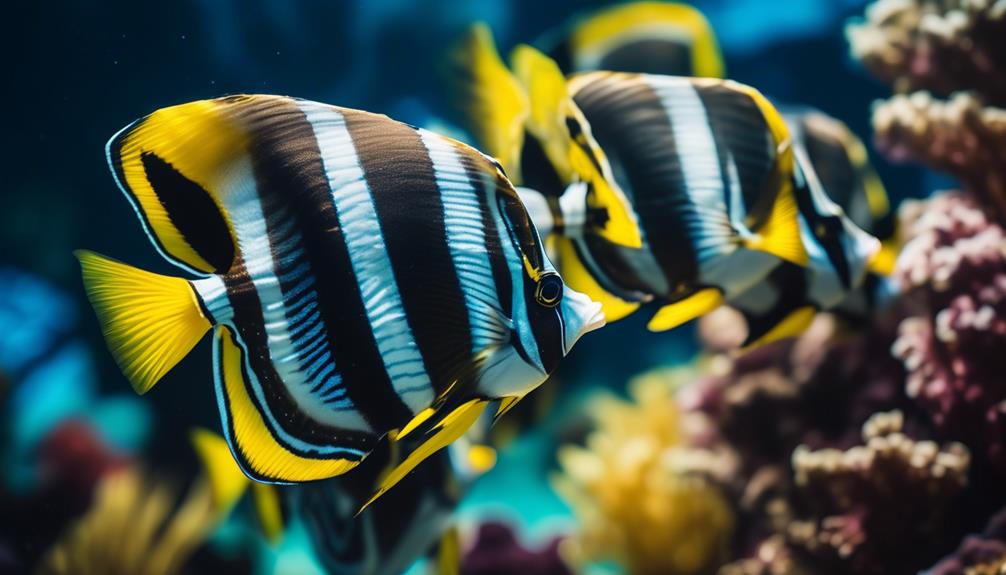
Aquarium enthusiasts often gravitate towards butterflyfish due to their vibrant colors and unique characteristics. There are various varieties of butterflyfish available in the aquarium trade, each with its own distinct colorations and patterns. Some popular varieties include the Raccoon, Auriga, Yellow Longnose, Teardrop, and Sunset butterflyfish. These varieties can add a stunning visual appeal to any aquarium.
However, it's important to note that different varieties may have slightly different care requirements. It's crucial for hobbyists to thoroughly research the specific needs of the variety they choose to ensure their proper care and maintenance.
Availability of different butterflyfish varieties may vary in different regions, so it's advisable to check with local aquarium stores or breeders for the availability of your desired variety.
Frequently Asked Questions
What Are Some Common Diseases or Health Issues That Butterflyfish May Experience?
Butterflyfish can experience common health issues such as ich, fin rot, and parasitic infections. It's important to maintain proper water quality, provide a balanced diet, and quarantine new additions to prevent the spread of diseases.
How Long Do Butterflyfish Typically Live in Captivity?
Butterflyfish typically live around 5 to 7 years in captivity. Proper care, diet, and tank conditions are crucial for their longevity. Regular monitoring and prompt treatment of any health issues can help ensure a healthy and fulfilling lifespan.
Are There Any Specific Tank Decorations or Plants That Are Beneficial for Butterflyfish?
Some butterflyfish benefit from live rock and coral in their tank for food and hiding spots. Other than that, you can choose tank decorations and plants based on your own preferences and the needs of your specific butterflyfish species.
Can Butterflyfish Be Kept in a Reef Tank With Other Coral Species?
Yes, butterflyfish can be kept in a reef tank with other coral species. However, it is important to research compatibility and ensure that the tank provides enough space and hiding spots for all the inhabitants.
What Are Some Common Signs of Stress or Aggression in Butterflyfish?
Common signs of stress or aggression in butterflyfish include fin clamping, rapid breathing, aggressive chasing or biting, hiding or seeking shelter, loss of appetite, and changes in coloration or behavior.
What Makes the Habitat of Butterflyfish Dazzling and Unique?
The secrets to happy reedfish habitat are what make the habitat of butterflyfish dazzling and unique. These colorful creatures thrive in vibrant coral reefs, where they can find ample food and shelter. The rich biodiversity and stunning array of colors in their habitat make it a sight to behold.
Conclusion
So, as you dive into the world of butterflyfish, you'll discover a mesmerizing realm filled with vibrant colors and elusive beauty. These stunning creatures, with their unique evolutionary adaptations, captivate us with their dazzling patterns.
However, caring for butterflyfish can be challenging, as their specific dietary and environmental requirements must be met. From researching their dietary needs to overcoming breeding challenges, maintaining ideal water parameters is crucial.
But with dedication and knowledge, you can create a thriving aquarium filled with these captivating fish.




